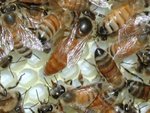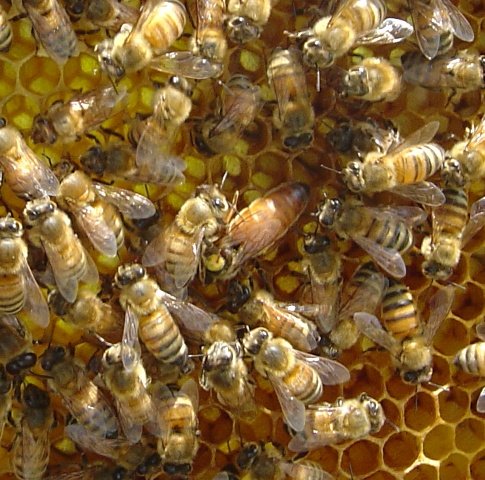.
.
 .
..
Right: Honey bees collecting water. The water will be used to cool the hive on hot summer days.
.
.
.
.
.
.
.
On hot days the bees will be busy collecting water to keep the hive cool, and searching about to find what little pollen and nectar they can. For the beekeeper it is time to estimate how much surplus honey has been produced by the bees, that is how much honey the bees have produced for the beekeeper. We will be extracting honey towards the end of August. This will leave time to feed the bees if necessary, examine them for disease and treat them accordingly
This was a poor honey production year. What should have produce 350 lbs of honey will only produce around 50. The cold spring did not allow the colonies to build up in size enough to take advantage of the spring honey flow. Perhaps the fall Golden Rod will produce some extra honey for the hives, but not for the beekeeper. Honey production was so low this year that supplemental feeding will be necessary to ensure the colonies have enough honey stored for winter.
.
.
 .
..
Left: Thats me, working the bees in the thunder and lightning.
.
.
.
.
.
.
.
.
.
Last week I was caught in a thunder and lightning rain storm while working the bees out on one of the cranberry bogs. Needless to say I was a little concerned for myself. There was lightning and loud thunder all around me. The bees didn’t seem to care about the danger I was in. They were actually calm during the whole ordeal.
I wasn’t.
.
.
.
 .
..
Right: Beautiful brood pattern layed by one of my home grown queens.
.
.
.
.
.
.
.
My queen rearing project has produced four nice queens. You can see from the photograph that they are laying a nice solid pattern of brood. Today I introduced one into a colony who’s queen is failing. Earlier this morning I prepared some queen cage candy by mixing 1 cup of powdered sugar to about 3 table spoons of corn syrup to make a bread dough like candy. This candy is placed into one end of the queen cage, and the queen and some attendant workers placed in the other end, covered by a screen. The plans is, that once the cage is introduced into a queenless colony, the bees will eat the candy out of one end, releasing the queen into the colony. It takes about 3 days for the bees to eat their way through the candy. By the time the queen is released, her “queen sent” has been passed through the entire colony, and she is accepted as their queen. If not, they kill her and try to raise their own queen.
.
.

.
.
Right: Queen cages filled with queen cage candy, ready for use.
.
.
.
.
.
This time of year is a difficult one to try to get a colony to accept a new queen. They are very protective of the hive. Because of the lack of a nectar flow, colonies of bees will try to rob weaker colonies of their honey. The bees are very sensitive to any intrusion into the hive this time of year.
.

.
.
.
Right: A queen in her cage, ready for introduction into a colony.
.
.
.
.
Maybe they somehow sense that in a few weeks a lot of their honey will be missing from their hives, and found on my pantry shelf!
.
.

.
.
Left: A bee on my shirt
.
.
.
.








No comments:
Post a Comment